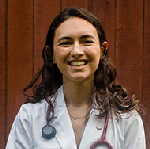Selin Ocal, BS, MS2, New York University Long Island School of Medicine
Selin Ocal, BS, MS2, New York University Long Island School of Medicine
 |
| Selin Ocal, BS, MS2 |
Some aspects of radiology may become habitual as we move deeper into training: certain patterns are reflexively recognizable and certain interpretations can be algorithmic. In many ways, this is indicative of good education and skill. With a systematic approach, it is harder to miss critical, and often subtle, signals of pathology. But is it possible that in the pursuit of such methodical expertise, we lose connection with the patient — the person — on our screen? What can we do to reconnect with those whose body’s puzzles we are charged with solving?
As a medical student, my eyes are new to these customs — I am still learning about the radiologist’s role in influencing the course of each patient’s tomorrow. When catching a 16-year-old's MCL tear, does the radiologist ever think about the patient’s impending disappointment, knowing that she’ll now sit on the bench for the rest of her high school soccer season? Does the radiologist still wonder what the 72-year-old's spouse, children or grandchildren will do now that there is a picture to prove why their loved one’s forgetfulness has burgeoned? Although there are many means through which we can connect with our radiology colleagues intellectually (e.g., research, scientific publications, etc.), there is little we do to both explore and share our sentiments about our profession, emotionally and psychologically. I pose that literature — particularly poetry — can be a medium through which radiologists can both capture and display their feelings as clinicians in our unique field.
As both an aspiring radiologist and avid writer, I have tried to meld some of these observations into the lines of my poems in an attempt to rhythmically and vividly exhibit my impressions of this distinctive profession. Poets in medicine, such as William Carlos Williams, John Keats and Oliver Wendell Holmes, have made art of their experiences across specialties — why should radiology be exempt?
Learning to read
Where are we?
Well, that’s
the liver.
Right? Right.
And that? Spleen?
Yes. Swelling ... there
Kidneys, obviously
Vessels, in front
Snaking, should be
pancreas
Swirling, dark, dense
so that’s — what —
I scroll,
Cyst? Not quite
I scroll,
Sitting, I count
years, in the left corner
It glows
A name
to a body, apart from me
Who will
tell her?